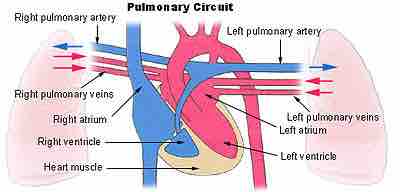There are two primary types of circulation in the human.
- Pulmonary circulation refers to blood supply to the lungs for the purpose of gas exchange.
- Systemic circulation refers to blood supply to the rest of the body, for the purpose of supplying oxygen to the tissues.
Bronchial circulation (by the bronchial arteries) supplies blood to the tissues of the bronchi and the pleura, and is considered part of systemic circulation.
Pulmonary Circulation
The right side of the heart deals with pulmonary circulation. At the end of systemic circulation, the veins take blood back to the heart through the vena cava.
The vena cava fills the right atrium with blood, which then ejects blood into the right ventricle by passing through the tricuspid valve. After blood fills in the right ventricle, it contracts and pumps the blood through the pulmonary valve, and into the pulmonary arteries.
There are two pulmonary arteries (one for each lung) that bring the deoxygenated blood to the lungs through the hilium. The arteries branch into the capillaries of the alveoli. Capillaries are the thinnest and smallest type of blood vessel, and they supply oxygen to individual tissues everywhere in the human body.
Gas exchange occurs by passive diffusion in the alveoli, so that dissolved oxygen enters the capillaries, while carbon dioxide leaves pulmonary circulation. The oxygenated blood then leaves the lungs through pulmonary veins (also contained in the hilium), which return the blood to the left side of the heart, completing the cycle of pulmonary circulation.
This blood then enters and fills inside the left atrium, which pumps it through the mitral valve (also called bicuspid) into the left ventricle. The blood fills inside the left ventricle and is then pumped through the aortic valve into the aorta, which marks the beginning of systemic circulation.
Systemic circulation and pulmonary circulation form the overall cycle of the circulatory system: transporting oxygen throughout the body.

Pulmonary circuit
Diagram of pulmonary circulation. Oxygen-rich blood is shown in red; oxygen-depleted blood in blue.
Problems in Pulmonary Circulation
While the cycle of pulmonary and systemic circulation is a well designed and effective system, it is not immune to certain problems. The most serious issue in pulmonary circulation is a pulmonary embolism, which is where a blood clot travels to the lung and causes an infarction of the lung (tissue death from lack of oxygen).
These blood clots typically originate in the deep veins of the legs (part of systemic circulation) as a result of blood pooling from injury or immobilization. As the veins of the leg are on their way to the right side of the heart, the clots are less likely to break up before they reach pulmonary circulation.
When the clot reaches the pulmonary artery, it obstructs the flow of blood into the lung, which causes the alveoli in the effected lung to die as a result. This results in an increase in aveolar dead space and decreased perfusion, (leading to shortness of breath and chest pain) and can be fatal if not treated in time by fibrinolytics (medications that dissolve the clot).